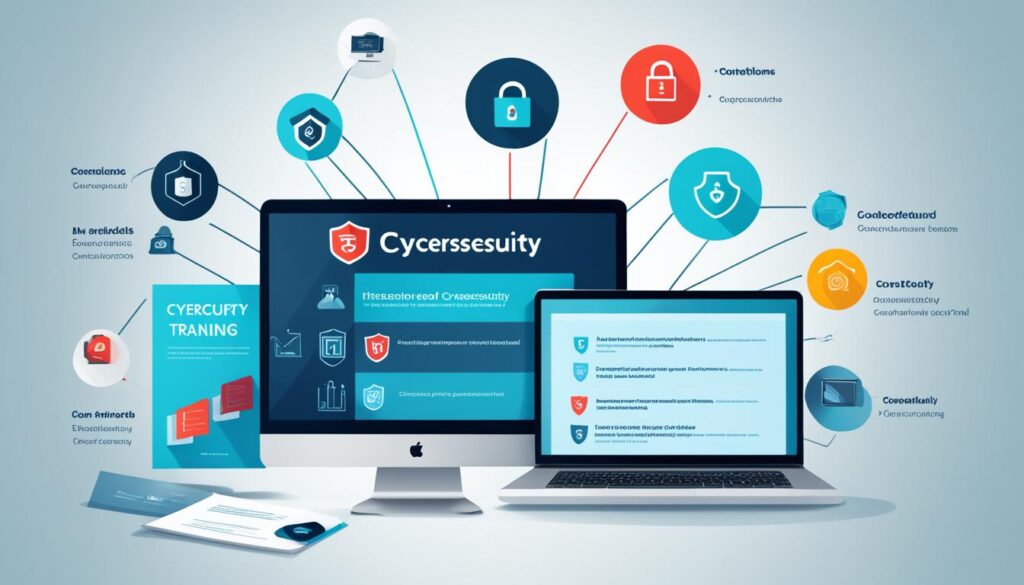
Cybersecurity training is a critical component when it comes to reducing risks for organizations. In today’s digital landscape, where cyber threats are constantly evolving and becoming more sophisticated, it is crucial for individuals to have the necessary skills and knowledge to effectively combat these threats. Cybersecurity training equips individuals with the tools they need to identify vulnerabilities, assess risks, and develop strategies to address them. By investing in cybersecurity training, organizations can significantly enhance their overall security posture and mitigate the potential impact of cyber-attacks.
Key Takeaways:
- Cybersecurity training plays a vital role in mitigating risks for organizations.
- It equips individuals with the necessary skills to combat evolving cyber threats.
- Investing in cybersecurity training enhances an organization’s overall security posture.
- Regular risk assessments are a crucial part of cybersecurity programs.
- Cybersecurity training provides practical skills for performing comprehensive risk assessments.
Personal perspective and expertise:
As a cybersecurity professional with several years of experience, I have witnessed firsthand the importance of cybersecurity training in reducing risks for organizations. Through training programs, I have gained valuable knowledge and practical skills that have enabled me to identify vulnerabilities, assess risks, and develop effective strategies to protect against cyber threats. I have seen organizations that have invested in cybersecurity training benefit from improved security postures and reduced instances of data breaches and cyber-attacks. It is clear that cybersecurity training is essential in today’s digital landscape, and I highly recommend organizations and individuals to prioritize it to stay ahead of the constantly evolving threat landscape.
Benefits of Cybersecurity Training for Risk Mitigation
Cybersecurity training plays a critical role in enhancing cybersecurity awareness and preventing cyber threats. By equipping individuals with the necessary knowledge and skills, online security training programs empower them to identify and mitigate potential risks, minimizing the likelihood of data breaches and cyber-attacks.
Through cybersecurity awareness training, individuals develop a deeper understanding of the cyber threats that organizations face. They learn about the various techniques employed by malicious actors and gain insights into their motivations. This heightened awareness enables individuals to proactively identify and respond to potential cyber threats, safeguarding sensitive data and systems.
Online security training programs also provide individuals with the skills to implement effective security measures. They learn about industry best practices and technologies that can help prevent cyber-attacks. By understanding the fundamentals of cyber threat prevention, individuals can apply appropriate security controls and ensure the integrity and confidentiality of organizational data.
One of the key benefits of cybersecurity training is the ability to respond to cyber threats quickly and effectively. Through hands-on exercises and simulations, individuals learn how to assess potential risks and develop incident response plans. This proactive approach allows organizations to minimize the impact of cyber incidents, reducing downtime and financial losses.
In addition, cybersecurity training programs foster a culture of security within organizations. By providing employees with the necessary knowledge and skills, organizations can create a workforce that is actively engaged in protecting sensitive information. This collective effort strengthens the overall cybersecurity posture of the organization, making it more resilient against cyber threats.
| Benefits of Cybersecurity Training |
|---|
| Enhanced cybersecurity awareness |
| Effective cyber threat prevention |
| Quick and efficient response to cyber threats |
| Cultivation of a security-focused culture |
Enhanced Cybersecurity Awareness
Cybersecurity training programs raise awareness among individuals about the potential cyber threats organizations face. By staying informed about the latest attack vectors and vulnerabilities, individuals can better identify and mitigate risks, ensuring the security of organizational assets.
Effective Cyber Threat Prevention
Online security training programs equip individuals with the knowledge and skills to effectively prevent cyber threats. Participants learn about industry best practices, security technologies, and risk management strategies that enable them to implement robust security measures and protect against potential cyber-attacks.
Quick and Efficient Response to Cyber Threats
Cybersecurity training programs provide hands-on experience and simulations that prepare individuals to respond swiftly and effectively to cyber incidents. By practicing incident response plans, organizations can minimize the impact of cybersecurity breaches and prevent further damage to systems and data.
Cultivation of a Security-Focused Culture
Cybersecurity training programs promote a culture of security within organizations. By educating employees about the importance of cybersecurity and their roles in protecting sensitive information, organizations can create a workforce that actively contributes to the overall security posture. This collective effort strengthens the organization’s resilience against cyber threats.
The Role of Risk Assessments in Cybersecurity Training
Risk assessments are a fundamental aspect of cybersecurity training. They play a crucial role in cyber risk management, helping organizations identify and manage potential risks to their systems and data. By conducting thorough risk assessments, organizations can develop effective strategies for risk mitigation and implement appropriate safeguards to prevent data breaches and other cyber-attacks.
During cybersecurity training, individuals acquire the necessary skills to perform accurate and comprehensive risk assessments. This training equips them with the knowledge and tools to identify vulnerabilities, evaluate potential threats, and quantify the impact of these risks on the organization’s security posture. Through practical exercises and case studies, participants gain hands-on experience in assessing risks and developing proactive mitigation strategies.
One of the key benefits of risk assessments in cybersecurity training is their ability to identify weaknesses in an organization’s defense strategies. By understanding the potential risks, including those specific to their industry and infrastructure, organizations can prioritize their resources and focus on implementing the most effective mitigation controls.
Furthermore, risk assessments provide valuable insights into the potential consequences of a data breach, such as financial losses, reputational damage, and regulatory non-compliance. Armed with this knowledge, organizations can make informed decisions about investing in cybersecurity measures and allocate their resources wisely.
A comprehensive risk assessment should include:
- Evaluating the organization’s assets, including sensitive data, hardware, and software
- Identifying potential threats and vulnerabilities
- Assessing the likelihood and potential impact of a successful cyber-attack
- Developing a risk treatment plan that outlines mitigation strategies and controls
- Regularly reviewing and updating the risk assessment to address new threats and vulnerabilities
By incorporating risk assessments into cybersecurity training programs, organizations can strengthen their overall security posture and reduce the likelihood of data breaches and cyber-attacks. Through continuous training and improvement, individuals can stay vigilant and adapt to the ever-evolving cyber threat landscape.
Skills Acquired through Cybersecurity Training
Cybersecurity training equips individuals with a range of skills essential for managing cyber risks. Participants gain knowledge and expertise in various areas that contribute to effective risk management and defense against cyber threats. Some of the key skills acquired through cyber defense training include:
1. Understanding the Business Context for Risk Management
Participants learn to assess the specific cybersecurity needs of their organization and understand how cyber risks impact business operations. This skill ensures that risk management strategies align with the organization’s goals and objectives.
2. Creating a Cybersecurity Program Charter
A cybersecurity program charter outlines the policies, procedures, and guidelines for implementing effective cybersecurity measures within an organization. Training equips individuals with the knowledge and skills to develop comprehensive charters that address specific risks and compliance requirements.
3. Evaluating Cybersecurity Documentation
Effective cybersecurity relies on well-documented policies, standards, and guidelines. Through training, individuals learn how to evaluate and analyze cybersecurity documentation to ensure compliance with industry best practices and regulatory requirements.
4. Choosing Appropriate Safeguards
Understanding the various cybersecurity safeguards available is crucial for selecting the most suitable ones to protect an organization’s data and systems. Participants learn how to assess different safeguards, such as encryption, firewalls, and access controls, to make informed decisions that mitigate cyber risks effectively.
5. Performing Third-Party Risk Assessments
Organizations often collaborate with third-party vendors and partners, which introduces additional cybersecurity risks. Cyber defense training teaches individuals how to conduct thorough risk assessments of third-party relationships to ensure that appropriate security measures are in place.
6. Effective Risk Response and Reporting
Knowing how to respond to identified risks is critical for minimizing the impact of cyber threats. Training equips individuals with the skills to develop and implement effective risk response strategies, as well as report risks to relevant stakeholders in a clear and concise manner.
Cybersecurity training empowers individuals with the necessary skills to proactively manage cyber risks and safeguard organizations against potential threats. By acquiring these essential skills, individuals contribute to a stronger cybersecurity posture and help protect valuable data and systems from unauthorized access, data breaches, and cyber-attacks.
Hands-On Cybersecurity Training
Hands-on cybersecurity training provides students with practical experience in performing risk assessments. Through simulations and case studies, students engage in real-world scenarios that require critical thinking and problem-solving skills. They learn how to evaluate an organization’s governance model, create a comprehensive risk assessment plan, and examine the implementation of cybersecurity safeguards. This hands-on training ensures that students can apply their knowledge immediately in their professional roles.
During the hands-on cybersecurity risk assessment training, students gain valuable experience in:
- Evaluating an organization’s governance model
- Identifying potential vulnerabilities and threats
- Creating a comprehensive risk assessment plan
- Applying industry best practices for risk mitigation
- Examining the implementation of cybersecurity safeguards
- Developing incident response strategies
By actively participating in these activities, students develop a deep understanding of the complexities and challenges involved in managing cyber risks. They also hone their analytical skills and learn to think critically when assessing and addressing potential vulnerabilities.
The hands-on approach ensures that students are prepared to face real-world cybersecurity challenges and effectively contribute to their organization’s risk mitigation efforts.
| Benefits of Hands-On Cybersecurity Training | Explanation |
|---|---|
| Practical Experience | Students gain hands-on experience in performing risk assessments and implementing cybersecurity safeguards. |
| Real-World Scenarios | Simulations and case studies provide students with exposure to real-world cybersecurity challenges. |
| Critical Thinking Skills | Students develop critical thinking and problem-solving skills necessary for effective risk assessment and mitigation. |
| Immediate Application | Students can apply their knowledge and skills immediately in their professional roles. |
Testimonials from Cybersecurity Training Participants
Participants in cybersecurity training programs have provided positive feedback on the effectiveness of the training. They appreciate the realistic scenarios presented during the training, which require them to make informed decisions and prioritize actions. Testimonials highlight the value of interactive training activities and the opportunity to practice critical thinking. Participants also express satisfaction with the practical skills gained and their ability to apply them in the workplace.
Participant Testimonial 1
“The cybersecurity training program I attended was incredibly beneficial. The scenarios simulated during the training were so realistic that it felt like I was dealing with actual cyber threats. This hands-on experience helped me sharpen my decision-making skills when it comes to prioritizing actions to mitigate risks. I now feel confident in my ability to protect our organization’s sensitive data.”
Participant Testimonial 2
“The interactive training activities in the cybersecurity program were a game-changer for me. They allowed me to apply my knowledge in a practical setting and think critically about the best course of action. It was challenging but incredibly rewarding. This training helped me develop a deeper understanding of cyber threats and how to respond effectively. I’m grateful for the opportunity to enhance my skills and make a real impact on our organization’s security.”
Participant Testimonial 3
“One of the things I appreciate most about the cybersecurity training is its emphasis on practical skills. The training equipped me with the necessary tools and techniques to identify and address cyber threats effectively. The knowledge gained from the program has not only boosted my confidence but also empowered me to contribute to our organization’s overall security. I highly recommend this training to anyone looking to enhance their cybersecurity expertise.”
Additional Benefits of Cybersecurity Training
In addition to risk mitigation, cybersecurity training offers numerous benefits to organizations. Let’s explore some of these key advantages:
1. Establishing the Business Case for a Cybersecurity Risk Assessment
Cybersecurity training helps organizations understand and articulate the importance of conducting regular risk assessments. By demonstrating the potential impact of cyber threats and the need for proactive risk management, cybersecurity training equips businesses to make a compelling case for investing in robust cybersecurity measures.
2. Meeting Regulatory Requirements
In an increasingly stringent regulatory landscape, cybersecurity training ensures organizations stay compliant with data protection and privacy laws. By educating employees on the latest regulations and best practices, training programs enable organizations to implement effective cybersecurity controls and avoid legal and financial penalties.
3. Facilitating Effective Communication and Reporting
Cybersecurity training equips individuals with the knowledge and skills to effectively communicate cyber risks to both business and technical stakeholders. By fostering a common understanding of cybersecurity terminology and concepts, training programs enable seamless collaboration among teams and facilitate the reporting of risks in a clear and concise manner.
4. Enhancing Overall Cybersecurity Posture
Effective cybersecurity training strengthens an organization’s overall cybersecurity posture by improving the awareness, knowledge, and skills of its workforce. Trained individuals are better equipped to identify potential security threats, implement appropriate security measures, and respond promptly to cyber incidents, ultimately minimizing the risk of data breaches and other cybersecurity incidents.
5. Supporting Strategic Objectives
Cybersecurity training aligns with an organization’s strategic objectives, such as expanding into new markets, launching innovative products, or enhancing customer trust. By proactively addressing cybersecurity concerns, organizations can build a reputation of trust and reliability, differentiate themselves from competitors, and foster long-term business growth.
Training Resources and Materials
Cybersecurity training programs provide a comprehensive set of resources and materials to support participants in their learning journey. These resources are carefully designed to enhance understanding, facilitate practical application, and ensure a well-rounded training experience.
Participants in cybersecurity training gain access to a variety of printed and electronic courseware, including training manuals, textbooks, and online modules. These materials serve as the foundation of the training program, covering core concepts, best practices, and real-world case studies.
To enhance the learning process, participants are provided with cybersecurity risk assessment templates, tools, and checklists. These resources enable them to apply their learning in a practical setting, analyze and assess risks, and develop effective risk mitigation strategies. With these templates and tools, participants can streamline their risk assessment process and ensure comprehensive coverage of potential vulnerabilities.
Interactive web apps play a vital role in cybersecurity training, allowing participants to engage with the content in an active and dynamic way. These apps provide an immersive learning experience, offering simulations and scenarios that require participants to apply their knowledge and make informed decisions. This hands-on approach enhances critical thinking skills and prepares participants for real-world cybersecurity challenges.

| Training Materials | Description |
|---|---|
| Printed and electronic courseware | Detailed materials covering core concepts, best practices, and case studies. |
| Cybersecurity risk assessment templates, tools, and checklists | Resources to streamline risk assessments and develop risk mitigation strategies. |
| Interactive web apps | Engaging simulations and scenarios for hands-on learning and decision-making. |
| Audio files of course lectures | Recordings to help participants revisit key concepts and reinforce learning. |
| Exercise workbooks and case study instructions | Practical exercises to enhance understanding and application of concepts. |
With a wide range of resources and materials at their disposal, participants in cybersecurity training can confidently acquire the knowledge and skills necessary for effective risk mitigation and cybersecurity management.
System Requirements for Cybersecurity Training
To fully participate in cybersecurity training, participants must ensure that their systems meet specific requirements. The system requirements for cybersecurity training are as follows:
| Processor | RAM | Storage Space | Wireless Capability | USB-A Capability | Operating System | Administrator Rights |
|---|---|---|---|---|---|---|
| 64-bit Intel i5/i7 processor or equivalent | At least 8GB of RAM | 20GB of free storage space | Wireless 802.11 capability | USB-A read/write capability | The latest version of Windows or macOS | Local administrator rights |
Participants should ensure that their systems meet these requirements to effectively engage in cybersecurity training and take full advantage of the learning materials and exercises.
The Importance of Cybersecurity Risk Management
Cybersecurity risk management is crucial for organizations to effectively identify, prioritize, and manage cyber risks. It enables organizations to develop and implement strategies, policies, and controls to mitigate risks and protect critical assets. By adopting a risk-based approach, organizations can allocate resources efficiently and respond to emerging cyber threats proactively. Cybersecurity training plays a vital role in equipping individuals with the knowledge and skills needed for effective risk management.
Cybersecurity risk management involves the systematic identification and assessment of potential risks, followed by the implementation of appropriate measures to minimize the impact of these risks. Effective risk management allows organizations to identify vulnerabilities in their systems and take necessary steps to protect against cyber attacks and data breaches.
One of the key aspects of cybersecurity risk management is conducting regular risk assessments. These assessments help organizations understand their current security posture, identify potential vulnerabilities, and prioritize risks based on their criticality and potential impact. Through risk assessments, organizations can develop strategies and controls to mitigate these risks and strengthen their overall security posture.
Furthermore, cybersecurity risk management helps organizations align their security investments with their business objectives. By understanding the potential impact of cyber risks on their operations, organizations can allocate resources effectively and implement preventive measures that provide the most significant return on investment.
Another important aspect of cybersecurity risk management is incident response planning. By having a well-defined incident response plan in place, organizations can minimize the impact of cyber incidents and efficiently recover from them. Cybersecurity training equips individuals with the knowledge and skills to develop and implement effective incident response plans, ensuring that organizations can respond swiftly and effectively to cyber incidents.
In summary, cybersecurity risk management is essential for organizations to protect their critical assets and information from cyber threats. It enables organizations to proactively identify and prioritize risks, develop effective strategies and controls, and align their security investments with their business objectives. Cybersecurity training plays a vital role in equipping individuals with the necessary knowledge and skills to effectively manage these risks and safeguard organizations from cyber attacks and data breaches.
Center for National Security Studies Certification
Completion of cybersecurity training programs often leads to certifications that hold significant value in the cybersecurity field. One such notable certification is the Center for National Security Studies Certification, offered through the UW Center for Information Assurance & Cybersecurity.
The Center for National Security Studies Certification is widely recognized by the National Security Agency (NSA) and serves as a testament to an individual’s expertise in cybersecurity risk management. This certification demonstrates a deep understanding of the principles and best practices necessary to safeguard organizations from cyber threats.
Obtaining the Center for National Security Studies Certification can have numerous benefits for professionals in the cybersecurity industry. It enhances career opportunities and opens doors to a wide range of positions that require specialized knowledge and skills in cybersecurity risk management.
The certification also boosts credibility and builds trust with employers and clients who recognize the rigorous standards associated with the Center for National Security Studies Certification. It serves as a tangible validation of an individual’s expertise, giving them a competitive edge in the field.
Moreover, the recognition by the NSA showcases the high level of excellence and rigor associated with the Center for National Security Studies Certification. This recognition solidifies the credibility of the certification and its alignment with industry standards and best practices.
By earning the Center for National Security Studies Certification, cybersecurity professionals demonstrate their commitment to continuous learning and professional development. This certification serves as a testament to their dedication to staying updated on the latest advancements and trends in the field of cybersecurity risk management.
Investing in the Center for National Security Studies Certification offers professionals a unique opportunity to differentiate themselves in the increasingly competitive cybersecurity landscape and advance their careers in this rapidly evolving industry.

Benefits of the Center for National Security Studies Certification
- Enhanced career opportunities in the cybersecurity field
- Increased credibility and trust with employers and clients
- Recognition by the National Security Agency (NSA)
- Validation of expertise in cybersecurity risk management
- Competitive advantage in the industry
Future of Cybersecurity Training and Risk Mitigation
The field of cybersecurity is constantly evolving, with new threats and challenges emerging at an alarming rate. To safeguard organizations against these evolving risks, cybersecurity training must adapt and progress. The future of cybersecurity training will focus on equipping individuals with the necessary skills to address emerging technologies and advanced threat detection techniques.
One key area of focus will be on emerging technologies, such as artificial intelligence (AI) and machine learning (ML). These technologies have the potential to both enhance cybersecurity defenses and create new vulnerabilities. Future cybersecurity training programs will enable professionals to understand and effectively utilize AI and ML to detect and respond to cyber threats.
Moreover, advanced threat detection and response techniques will play a crucial role in the future of cybersecurity training. As cybercriminals become increasingly sophisticated, organizations must be equipped with cutting-edge strategies and tools to combat these threats. Cybersecurity training will provide professionals with the knowledge and skills to effectively identify, analyze, and respond to evolving cyber attacks.
In conclusion, continuous learning and professional development will be paramount for individuals in the cybersecurity field. Staying updated with the latest trends and techniques will enable professionals to mitigate risks effectively and protect organizations from cyber threats. As the future of cybersecurity unfolds, training programs will play a vital role in equipping professionals with the necessary skills to adapt and thrive in this rapidly evolving field.






